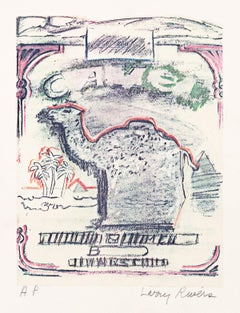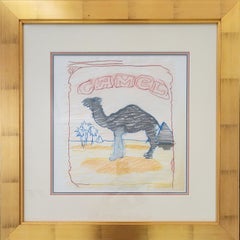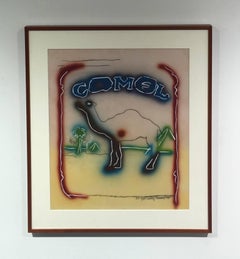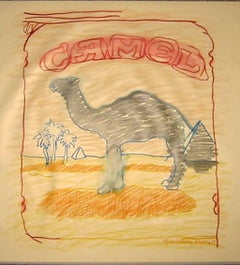Larry Rivers Camel
1980s Pop Art Abstract Prints
Lithograph
1970s Prints and Multiples
Crayon, Graphite, Lithograph, Screen
1970s Pop Art Figurative Prints
Lithograph, Stencil
Recent Sales
1970s Pop Art Prints and Multiples
Lithograph
1970s Pop Art Prints and Multiples
Lithograph
1980s Pop Art Abstract Prints
Lithograph
1980s Pop Art Abstract Prints
Lithograph
1980s Pop Art Figurative Prints
Archival Paper, Graphite, Lithograph, Stencil
1970s Figurative Prints
Paper, Stencil
People Also Browsed
Vintage 1960s American Contemporary Art
Paper
1970s Pop Art Portrait Prints
Screen, Lithograph
Larry Rivers Camel For Sale on 1stDibs
How Much is a Larry Rivers Camel?
Larry Rivers for sale on 1stDibs
Figurative artist Larry Rivers was born in the Bronx in 1923 to Ukrainian Jewish parents, and was named Yitzak Loiza Grossberg. Rivers belonged to the second generation of the New York School of painters, although unlike most of his contemporaries he stayed away from abstraction instead preferring narrative paintings. He began his artistic career playing the jazz saxophone, and when one night his group was introduced as "Larry Rivers and the Mudcats," he decided to keep the name.
After a brief period in the army during World War II, Rivers attended Juilliard School of Music for one year before returning to the jazz saxophone. After he met the painter Jane Freilicher, he decided to devote himself to painting. Rivers attended Hans Hofmann's school for nearly two years. In 1949, he had his first solo show at the Jane Street Gallery, an artist's co-op in the Village. Rivers received favorable reviews and was invited to join the Tibor de Nagy Gallery uptown.
Rivers continued to show annually at the Tibor de Nagy Gallery from 1952 to 1962. In 1963, he joined the Marlborough Gallery, where he stayed until his death. In 1955, The New York Museum of Modern Art acquired his painting Washington Crossing the Delaware, and in 1956 the Whitney Museum purchased Double Portrait of Berdie, two of his more famous paintings. He had periodic museum shows in Europe and the United States throughout his career.
Rivers had two sons, Joseph and Steven, by his first wife, Augusta. In 1961 he married Clarice Price and had two more children, Gwynne and Emma. In the 1970s he had another son with the painter Daria Deshuk.
The subjects of River's figurative paintings were family, history, politics, religion and sex. His work done in oils often included the use of stencils, cutouts, blank canvas and image reversals. He often painted family members including his mother in law, his sons and his ex-wife. Rivers favored historical subjects such as History of Matzah: The Story of the Jews (1984-85), History of the Russian Revolution (1965) and often painted parodies including his Washington Crossing the Delaware. He enjoyed controversial subjects and shocking the public. Lapman Loves It (1966) is a nine-foot electrified assemblage complete with strategically located light bulbs. French Vocabulary Lesson (1961-62) is a nude with body parts labeled in French.
Rivers was also a writer. In 1979 he published Drawings and Digressions with Carol Brightman. In 1992 he published What Did I Do? The Unauthorized Autobiography with Arnold Weinstein.
Find original Larry Rivers prints and paintings on 1stDibs.
(Biography provided by Lincoln Glenn)
Finding the Right Prints And Multiples for You
Decorating with fine art prints — whether they’re figurative prints, abstract prints or another variety — has always been a practical way of bringing a space to life as well as bringing works by an artist you love into your home.
Pursued in the 1960s and ’70s, largely by Pop artists drawn to its associations with mass production, advertising, packaging and seriality, as well as those challenging the primacy of the Abstract Expressionist brushstroke, printmaking was embraced in the 1980s by painters and conceptual artists ranging from David Salle and Elizabeth Murray to Adrian Piper and Sherrie Levine.
Printmaking is the transfer of an image from one surface to another. An artist takes a material like stone, metal, wood or wax, carves, incises, draws or otherwise marks it with an image, inks or paints it and then transfers the image to a piece of paper or other material.
Fine art prints are frequently confused with their more commercial counterparts. After all, our closest connection to the printed image is through mass-produced newspapers, magazines and books, and many people don’t realize that even though prints are editions, they start with an original image created by an artist with the intent of reproducing it in a small batch. Fine art prints are created in strictly limited editions — 20 or 30 or maybe 50 — and are always based on an image created specifically to be made into an edition.
Many people think of revered Dutch artist Rembrandt as a painter but may not know that he was a printmaker as well. His prints have been preserved in time along with the work of other celebrated printmakers such as Pablo Picasso, Salvador Dalí and Andy Warhol. These fine art prints are still highly sought after by collectors.
“It’s another tool in the artist’s toolbox, just like painting or sculpture or anything else that an artist uses in the service of mark making or expressing him- or herself,” says International Fine Print Dealers Association (IFPDA) vice president Betsy Senior, of New York’s Betsy Senior Fine Art, Inc.
Because artist’s editions tend to be more affordable and available than his or her unique works, they’re more accessible and can be a great opportunity to bring a variety of colors, textures and shapes into a space.
For tight corners, select small fine art prints as opposed to the oversized bold piece you’ll hang as a focal point in the dining area. But be careful not to choose something that is too big for your space. And feel free to lean into it if need be — not every work needs picture-hanging hooks. Leaning a larger fine art print against the wall behind a bookcase can add a stylish installation-type dynamic to your living room. (Read more about how to arrange wall art here.)
Find fine art prints for sale on 1stDibs today.




